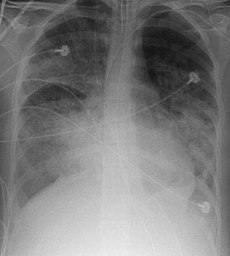The current mortality of 35% associated with acute lung injury (ALI) is roughly three times higher than that associated with ST-segment elevation myocardial infarction. Protective ventilation strategies limiting tidal volumes and plateau pressures improve outcome, but the optimial level of PEEP is debated. In patients with ALI and its more severe form acute respiratory distress syndrome (ARDS), higher levels of PEEP may prevent atelectasis, recruit already collapsed alveolar units, and reduce pulmonary damage by avoiding the cyclical opening and collapse of alveoli.

In a systematic review and meta-analysis of individual-patient data, researchers investigated the association between higher vs lower PEEP levels and patient-important outcomes among adults with acute lung injury or ARDS who receive ventilation with low tidal volumes.
Randomized trials eligible for this review compared higher with lower levels of PEEP (mean difference of at least 3 cm H2O between groups) in critically ill adults with ALI or ARDS. Eligible trials incorporated a target tidal volume of less than 8 mL/kg of predicted body weight in both the experimental and the control ventilation strategies and provided patient follow-up to death or for at least 20 days.

Three trials, including 2299 patients, met the eligibility criteria: the Assessment of Low Tidal Volume and Elevated End-Expiratory Pressure to Obviate Lung Injury (ALVEOLI) trial, the Lung Open Ventilation to Decrease Mortality in the Acute Respiratory Distress Syndrome (LOVS) study, and the Expiratory Pressure Study (EXPRESS).
There were 374 hospital deaths in 1136 patients (32.9%) assigned to treatment with higher PEEP and 409 hospital deaths in 1163 patients (35.2%) assigned to lower PEEP (adjusted relative risk [RR], 0.94; 95% confidence interval [CI], 0.86-1.04; P = .25). Treatment effects varied with the presence or absence of ARDS (as opposed to ALI). In patients with ARDS (n = 1892), there were 324 hospital deaths (34.1%) in the higher PEEP group and 368 (39.1%) in the lower PEEP group (adjusted RR, 0.90; 95% CI, 0.81-1.00; P = .049). Rates of pneumothorax and vasopressor use were similar.
The authors conclude that treatment with higher vs lower levels of PEEP was not associated with improved hospital survival overall when ALI/ARDS were considered together, but higher levels were associated with improved survival among the pre-defined subgroup of patients with ARDS.
Higher vs lower positive end-expiratory pressure in patients with acute lung injury and acute respiratory distress syndrome: systematic review and meta-analysis
JAMA. 2010 Mar 3;303(9):865-73
